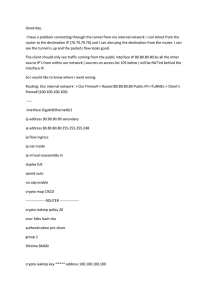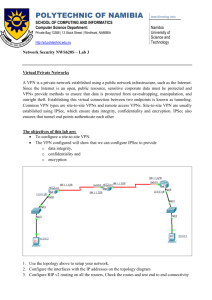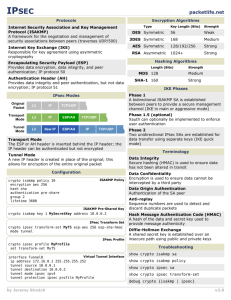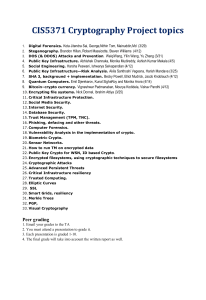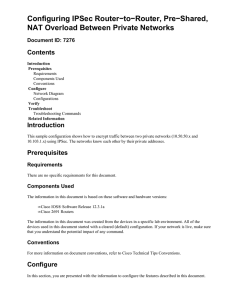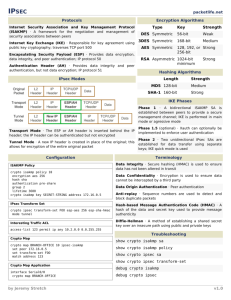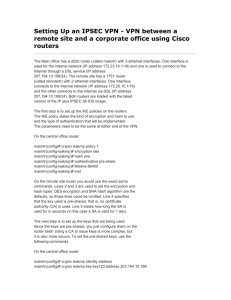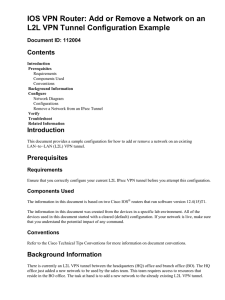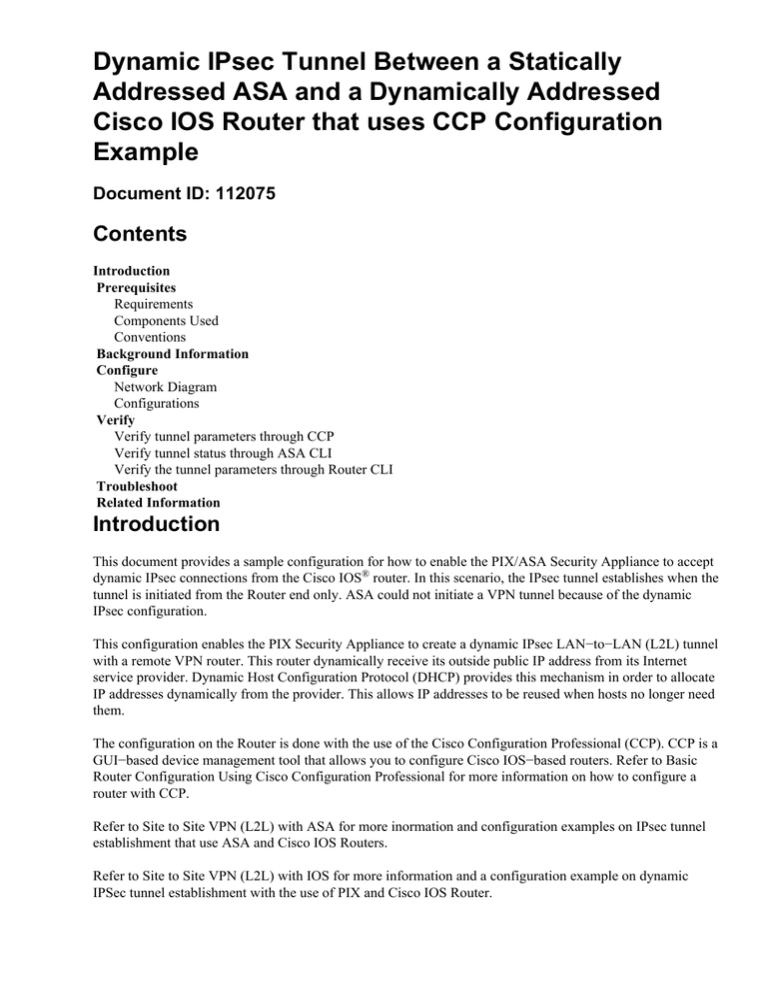
Dynamic IPsec Tunnel Between a Statically
Addressed ASA and a Dynamically Addressed
Cisco IOS Router that uses CCP Configuration
Example
Document ID: 112075
Contents
Introduction
Prerequisites
Requirements
Components Used
Conventions
Background Information
Configure
Network Diagram
Configurations
Verify
Verify tunnel parameters through CCP
Verify tunnel status through ASA CLI
Verify the tunnel parameters through Router CLI
Troubleshoot
Related Information
Introduction
This document provides a sample configuration for how to enable the PIX/ASA Security Appliance to accept
dynamic IPsec connections from the Cisco IOS® router. In this scenario, the IPsec tunnel establishes when the
tunnel is initiated from the Router end only. ASA could not initiate a VPN tunnel because of the dynamic
IPsec configuration.
This configuration enables the PIX Security Appliance to create a dynamic IPsec LAN−to−LAN (L2L) tunnel
with a remote VPN router. This router dynamically receive its outside public IP address from its Internet
service provider. Dynamic Host Configuration Protocol (DHCP) provides this mechanism in order to allocate
IP addresses dynamically from the provider. This allows IP addresses to be reused when hosts no longer need
them.
The configuration on the Router is done with the use of the Cisco Configuration Professional (CCP). CCP is a
GUI−based device management tool that allows you to configure Cisco IOS−based routers. Refer to Basic
Router Configuration Using Cisco Configuration Professional for more information on how to configure a
router with CCP.
Refer to Site to Site VPN (L2L) with ASA for more inormation and configuration examples on IPsec tunnel
establishment that use ASA and Cisco IOS Routers.
Refer to Site to Site VPN (L2L) with IOS for more information and a configuration example on dynamic
IPSec tunnel establishment with the use of PIX and Cisco IOS Router.
Prerequisites
Requirements
Before you attempt this configuration, ensure that both the ASA and router have Internet connectivity in order
to establish the IPSEC tunnel.
Components Used
The information in this document is based on these software and hardware versions:
• Cisco IOS Router1812 that runs Cisco IOS Software Release 12.4
• Cisco ASA 5510 software release 8.0.3
The information in this document was created from the devices in a specific lab environment. All of the
devices used in this document started with a cleared (default) configuration. If your network is live, make sure
that you understand the potential impact of any command.
Conventions
Refer to the Cisco Technical Tips Conventions for more information on document conventions.
Background Information
In this scenario, 192.168.100.0 network is behind the ASA and 192.168.200.0 network is behind the Cisco
IOS Router. It is assumed that the Router gets its public address through DHCP from its ISP. As this poses a
problem in the configuration of a static peer on the ASA end, you need to approach the way of dynamic
crypto configuration to establish a site−to−site tunnel between ASA and the Cisco IOS Router.
The Internet users at the ASA end get translated to the IP address of its outside interface. It is assumed that
NAT is not configured on the Cisco IOS router end.
Now these are the main steps to be configured on the ASA end in order to establish dynamic tunnel:
1. Phase 1 ISAKMP related configuration
2. Nat exemption configuration
3. Dynamic crypto map configuration
The Cisco IOS router has a static crypto map configured because the ASA is assumed to have a static public
IP address. Now this is the list of main steps to be configured on the Cisco IOS Router end to establish
dynamic IPSEC tunnel.
1. Phase 1 ISAKMP related configuration
2. Static crypto map related configuration
These steps are described in detail in these configurations.
Configure
In this section, you are presented with the information to configure the features described in this document.
Note: Use the Command Lookup Tool (registered customers only) to obtain more information on the
commands used in this section.
Network Diagram
This document uses this network setup:
Configurations
This is the IPsec VPN configuration on the VPN−Router with CCP. Complete these steps:
1. Open the CCP application and choose Configure > Security > VPN > Site to Site VPN. Click the
Launch the selected tab.
2. Choose Step−by−step wizard and then click Next.
3. Fill in the remote peer IP address along with the authentication details.
4. Choose the IKE proposals and click Next.
5. Define the transform−set details and click Next.
6. Define the traffic that needs to be encrypted and click Next.
7. Verify the summary of the crypto IPsec configuration and click Finish.
8. Click Deliver in order to send the configuration to the VPN−Router.
9. Click OK.
CLI Configuration
• Ciscoasa
• VPN−Router
Ciscoasa
ciscoasa(config)#show run
: Saved
:
ASA Version 8.0(3)
!
hostname ciscoasa
enable password 8Ry2YjIyt7RRXU24 encrypted
names
!
interface Ethernet0/0
nameif outside
security−level 0
ip address 209.165.201.2 255.255.255.224
!
interface Ethernet0/1
nameif inside
security−level 100
ip address 192.168.100.1 255.255.255.0
!
interface Ethernet0/2
shutdown
no nameif
no security−level
no ip address
!
interface Ethernet0/3
shutdown
no nameif
no security−level
no ip address
!
interface Management0/0
shutdown
no nameif
no security−level
no ip address
!
passwd 2KFQnbNIdI.2KYOU encrypted
ftp mode passive
!−−− Output suppressed
access−list nonat extended permit ip 192.168.100.0 255.255.255.0 192.168.200.0 255.255.255.0
no pager
mtu outside 1500
mtu inside 1500
icmp unreachable rate−limit 1 burst−size 1
asdm image disk0:/asdm−613.bin
no asdm history enable
arp timeout 14400
!
!−−− Define the nat−translation for Internet users
global (outside) 1 interface
nat (inside) 1 192.168.100.0 255.255.255.0
!
!
!−−− Define the nat−exemption policy for VPN traffic
nat (inside) 0 access−list nonat
!
route outside 0.0.0.0 0.0.0.0 209.165.201.1 1
!
timeout xlate 3:00:00
timeout conn 1:00:00 half−closed 0:10:00 udp 0:02:00 icmp 0:00:02
timeout sunrpc 0:10:00 h323 0:05:00 h225 1:00:00 mgcp 0:05:00 mgcp−pat 0:05:00
timeout sip 0:30:00 sip_media 0:02:00 sip−invite 0:03:00 sip−disconnect 0:02:00
timeout uauth 0:05:00 absolute
dynamic−access−policy−record DfltAccessPolicy
no snmp−server location
no snmp−server contact
snmp−server enable traps snmp authentication linkup linkdown coldstart
!
!−−− Configure the IPsec transform−set
crypto ipsec transform−set myset esp−des esp−md5−hmac
!
!
!−−− Configure the dynamic crypto map
crypto dynamic−map
crypto dynamic−map
crypto map dyn−map
crypto map dyn−map
!
!−−− Configure the
mymap 1 set transform−set myset
mymap 1 set reverse−route
10 IPSec−isakmp dynamic mymap
interface outside
phase I ISAKMP policy
crypto isakmp policy 10
authentication pre−share
encryption des
hash md5
group 2
lifetime 86400
!
!
!−−− Configure the default L2L tunnel group parameters
tunnel−group DefaultL2LGroup IPSec−attributes
pre−shared−key *
!
class−map inspection_default
match default−inspection−traffic
!
!
policy−map type inspect dns preset_dns_map
parameters
message−length maximum 512
policy−map global_policy
class inspection_default
inspect dns preset_dns_map
inspect ftp
inspect h323 h225
inspect h323 ras
inspect netbios
inspect rsh
inspect rtsp
inspect skinny
inspect esmtp
inspect sqlnet
inspect sunrpc
inspect tftp
inspect sip
inspect xdmcp
!
service−policy global_policy global
prompt hostname context
Cryptochecksum:d41d8cd98f00b204e9800998ecf8427e
: end
ciscoasa(config)#
CCP creates this configuration on the VPN−Router.
VPN−Router
VPN−Router#show run
Building configuration...
!
version 12.4
service timestamps debug datetime msec
service timestamps log datetime msec
no service password−encryption
!
hostname VPN−Router
!
!
username cisco privilege 15 secret 5 $1$UQxM$WvwDZbfDhK3wS26C9xYns/
username test12 privilege 15 secret 5 $1$LC0U$ex3tp4hM8CYD.HJSRDfQO1
!
!
!−−− Output suppressed
no aaa new−model
ip subnet−zero
!
ip cef
!
crypto isakmp enable outside
!
crypto isakmp policy 1
encrypt 3des
authentication pre−share
group 2
!
crypto isakmp policy 2
hash md5
authentication pre−share
group 2
!
!
crypto isakmp key cisco123 address 209.165.201.2
!
!
crypto ipsec transform−set myset esp−des esp−md5−hmac
!
!
crypto map SDM_CMAP_1 1 IPSec−isakmp
description Tunnel to209.165.201.2
set peer 209.165.201.2
set transform−set myset
match address 101
!
!
!
interface BRI0
no ip address
shutdown
!
interface Dot11Radio0
no ip address
shutdown
speed basic−1.0 basic−2.0 basic−5.5 6.0 9.0 basic−11.0 12.0 18.0 24.0 36.0 48.0 54.0
station−role root
!
interface Dot11Radio1
no ip address
shutdown
speed basic−6.0 9.0 basic−12.0 18.0 basic−24.0 36.0 48.0 54.0
station−role root
!
interface FastEthernet0
ip address 192.168.200.1 255.255.255.0
duplex auto
speed auto
!
interface FastEthernet1
ip address dhcp
duplex auto
speed auto
crypto map SDM_CMAP_1
!
interface FastEthernet2
no ip address
shutdown
!
interface FastEthernet3
no ip address
shutdown
!
interface FastEthernet4
no ip address
shutdown
!
interface FastEthernet5
no ip address
shutdown
!
interface FastEthernet6
no ip address
shutdown
!
interface FastEthernet7
no ip address
shutdown
!
interface FastEthernet8
no ip address
shutdown
!
interface FastEthernet9
no ip address
shutdown
!
interface Vlan1
no ip address
!
ip classless
ip route 0.0.0.0 0.0.0.0 209.165.200.1
!
!
!−−− Output suppressed
!
ip http server
ip http authentication
ip http secure−server
!
access−list 100 permit
access−list 101 remark
access−list 101 remark
access−list 101 permit
!
!
!
!
control−plane
!
local
ip 0.0.0.0 255.255.255.0 0.0.0.0 255.255.255.0
CCP_ACL Category=4
IPSEC Rule
ip 192.168.200.0 0.0.0.255 192.168.100.0 0.0.0.255
!
line con 0
line aux 0
line vty 0 4
privilege level 15
login local
transport input telnet ssh
line vty 5 15
privilege level 15
login local
transport input telnet ssh
!
no scheduler allocate
end
Verify
Use this section to confirm that your configuration works properly.
The Output Interpreter Tool (registered customers only) (OIT) supports certain show commands. Use the OIT
to view an analysis of show command output.
• Verifying the tunnel parameters through CCP
• Verifying the tunnel status through ASA CLI
• Verifying the tunnel parameters through Router CLI
Verify tunnel parameters through CCP
• Monitor the traffic passes through the IPsec tunnel.
• Monitor the status of the phase I ISAKMP SA.
Verify tunnel status through ASA CLI
• Verify the status of phase I ISAKMP SA.
ciscoasa#show crypto isakmp sa
Active SA: 1
Rekey SA: 0 (A tunnel will report 1 Active and 1 Rekey SA during rekey)
Total IKE SA: 1
1
IKE Peer: 209.165.200.12
Type
: L2L
Rekey
: no
ciscoasa#
Role
State
: responder
: MM_ACTIVE
Note: Observe the Role to be responder, which states that the initiator of this tunnel is at the other
end, for example, the VPN−Router.
• Verify the parameters of phase II IPSEC SA.
ciscoasa#show crypto ipsec sa
interface: outside
Crypto map tag: mymap, seq num: 1, local addr: 209.165.201.2
local ident (addr/mask/prot/port): (192.168.100.0/255.255.255.0/0/0)
remote ident (addr/mask/prot/port): (192.168.200.0/255.255.255.0/0/0)
current_peer: 209.165.200.12
#pkts encaps: 29, #pkts encrypt: 29, #pkts digest: 29
#pkts decaps: 29, #pkts decrypt: 29, #pkts verify: 29
#pkts compressed: 0, #pkts decompressed: 0
#pkts not compressed: 29, #pkts comp failed: 0, #pkts decomp failed: 0
#pre−frag successes: 0, #pre−frag failures: 0, #fragments created: 0
#PMTUs sent: 0, #PMTUs rcvd: 0, #decapsulated frgs needing reassembly: 0
#send errors: 0, #recv errors: 0
local crypto endpt.: 209.165.201.2, remote crypto endpt.: 209.165.200.12
path mtu 1500, IPSec overhead 58, media mtu 1500
current outbound spi: E7B37960
inbound esp sas:
spi: 0xABB49C64 (2880740452)
transform: esp−des esp−md5−hmac none
in use settings ={L2L, Tunnel, }
slot: 0, conn_id: 4096, crypto−map: mymap
sa timing: remaining key lifetime (kB/sec): (4274997/3498)
IV size: 8 bytes
replay detection support: Y
outbound esp sas:
spi: 0xE7B37960 (3887298912)
transform: esp−des esp−md5−hmac none
in use settings ={L2L, Tunnel, }
slot: 0, conn_id: 4096, crypto−map: mymap
sa timing: remaining key lifetime (kB/sec): (4274997/3498)
IV size: 8 bytes
replay detection support: Y
Verify the tunnel parameters through Router CLI
• Verify the status of phase I ISAKMP SA.
VPN−Router#show crypto isakmp sa
dst
src
state
209.165.201.2
209.165.200.12 QM_IDLE
conn−id slot status
1
0 ACTIVE
• Verify the parameters of phase II IPSEC SA.
VPN−Router#show crypto ipsec sa
interface: FastEthernet1
Crypto map tag: SDM_CMAP_1, local addr 209.165.200.12
protected vrf: (none)
local ident (addr/mask/prot/port): (192.168.200.0/255.255.255.0/0/0)
remote ident (addr/mask/prot/port): (192.168.100.0/255.255.255.0/0/0)
current_peer 209.165.201.2 port 500
PERMIT, flags={origin_is_acl,}
#pkts encaps: 39, #pkts encrypt: 39, #pkts digest: 39
#pkts decaps: 39, #pkts decrypt: 39, #pkts verify: 39
#pkts compressed: 0, #pkts decompressed: 0
#pkts not compressed: 0, #pkts compr. failed: 0
#pkts not decompressed: 0, #pkts decompress failed: 0
#send errors 6, #recv errors 0
local crypto endpt.: 209.165.200.12, remote crypto endpt.: 209.165.201.2
path mtu 1500, ip mtu 1500
current outbound spi: 0xABB49C64(2880740452)
inbound esp sas:
spi: 0xE7B37960(3887298912)
transform: esp−des esp−md5−hmac ,
in use settings ={Tunnel, }
conn id: 2001, flow_id: C18XX_MBRD:1, crypto map: SDM_CMAP_1
sa timing: remaining key lifetime (k/sec): (4481818/3375)
IV size: 8 bytes
replay detection support: Y
Status: ACTIVE
inbound ah sas:
inbound pcp sas:
outbound esp sas:
spi: 0xABB49C64(2880740452)
transform: esp−des esp−md5−hmac ,
in use settings ={Tunnel, }
conn id: 2002, flow_id: C18XX_MBRD:2, crypto map: SDM_CMAP_1
sa timing: remaining key lifetime (k/sec): (4481818/3371)
IV size: 8 bytes
replay detection support: Y
Status: ACTIVE
outbound ah sas:
outbound pcp sas:
Troubleshoot
This section provides information you can use to troubleshoot your configuration.
• Tearing down the existing crypto connections.
ciscoasa#clear crypto ipsec sa
ciscoasa#clear crypto isakmp sa
VPN−Router#clear crypto isakmp
• Use debug commands in order to troubleshoot the problems with VPN tunnel.
Note: If you enable debugging, this can disrupt the operation of the router when internetworks
experience high load conditions.Use debug commands with caution. In general, it is recommended
that these commands only be used under the direction of your router technical support representative
when troubleshooting specific problems.
ciscoasa#debug crypto engine
ciscoasa#debug crypto isakmp
ciscoasa#debug crypto IPSec
ciscoasa#
VPN−Router#debug crypto engine
Crypto Engine debugging is on
VPN−Router#debug crypto isakmp
Crypto ISAKMP debugging is on
VPN−Router#debug crypto ipsec
Crypto IPSEC debugging is on
VPN−Router#
Refer to debug crypto isakmp in Understanding and Using debug Commands for more information on debug
commangs.
Related Information
• IPSEC Negotiation/IKE Protocols Support Page
• Documentation for Cisco ASA Security Appliance OS Software
• Most Common IPSEC VPN Troubleshooting Solutions
• Requests for Comments (RFCs)
• Technical Support & Documentation − Cisco Systems
Contacts & Feedback | Help | Site Map
© 2014 − 2015 Cisco Systems, Inc. All rights reserved. Terms & Conditions | Privacy Statement | Cookie Policy | Trademarks of
Cisco Systems, Inc.
Updated: Jul 28, 2010
Document ID: 112075

